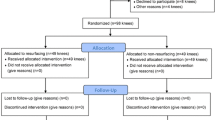Abstract
Background
Patellar crepitus (PC) is reported in up to 14% of subjects implanted with cruciate-substituting total knee arthroplasty (TKA). Numerous etiologies of PC have been proposed.
Questions/purposes
We determined when painful PC typically occurs postoperatively and compared patients undergoing primary TKA who developed painful PC requiring subsequent surgery with a matched group without this complication to identify clinical, radiographic, and surgical variables associated with this complication.
Methods
From the databases of two institutions (greater than 4000 TKAs), we identified 60 patients who required surgery for painful PC from 2002 to 2008. This group was then compared with an identified control group of 60 TKA subjects without PC who were matched for the key variables of age, gender, and body mass index to determine clinical, radiographic, and surgical factors associated with the development of PC.
Results
The mean time to presentation of PC was 10.9 months. The incidence of PC correlated with a greater number of previous knee surgeries, decreased patellar component size, decreased composite patellar thickness, shorter preoperative and postoperative patellar tendon length, increased posterior femoral condylar offset, use of smaller femoral components and thicker tibial polyethylene inserts, and placement of the femoral component in a flexed posture.
Conclusions
Many of the factors associated with an increased incidence of postoperative PC such as shortened patellar tendon length, use of smaller patellar components, decreased patellar composite thickness, and increased posterior femoral condylar offset may all increase quadriceps tendon contact forces against the superior aspect of the intercondylar box, increasing the risk of fibrosynovial proliferation and entrapment within the intercondylar region of the femoral component. Based on these findings, the authors recommend use of larger patellar components when possible, avoid oversection of the patella or increasing posterior femoral condylar offset, and advising patients preoperatively who have had previous knee surgery or demonstrate a shortened patellar tendon length of an increased risk of development of postoperative patellar crepitus.
Level of Evidence
Level III, therapeutic study. See Guidelines for Authors for a complete description of levels of evidence.


Similar content being viewed by others
References
Beight JA, Yao B, Hozack WJ, Hearn SL, Booth RE. The patellar ‘clunk’ syndrome after posterior stabilized total knee arthroplasty. Clin Orthop Relat Res. 1994;299:139–142.
Bellemans J, Banks S, Victor J, Vandenneucker H, Moemans A. Fluoroscopic analysis of the kinematics of deep flexion in total knee arthroplasty: influence of posterior condylar offset. J Bone Joint Surg Br. 2002;84:50–53.
Clarke HD, Fuchs R, Scuderi GR, Mills EL, Scott WN, Insall JN. The influence of femoral component design in the elimination of patellar clunk in posterior-stabilized total knee arthroplasty. J Arthroplasty. 2006;21:167–171.
Colizza WA, Insall JN, Scuderi GR. The posterior stabilized total knee prosthesis: assessment of polyethylene damage and osteolysis after a ten-year-minimum follow-up. J Bone Joint Surg Am. 1995;77:1713–1720.
Figgie HE, Goldberg VM, Heiple KG, Moller HS, Gordon NH. The influence of tibial-patellofemoral location on function of the knee in patients with the posterior stabilized condylar knee prosthesis. J Bone Joint Surg Am. 1986;68:1035–1040.
Fukunaga K, Kobayashi A, Minoda Y, Iwaki H, Hashimoto Y, Takaoka K. The incidence of the patellar clunk syndrome in a recently designed mobile-bearing posterior stabilized total knee replacement. J Bone Joint Surg Br. 2009;91:463–468.
Grelsamer RP, Meadows S. The modified Insall-Salvati ratio for assessment of patellar height. Clin Orthop Relat Res. 1992;282:170–176.
Hosmer DW, Lemeshow S. Applied Logistic Regression. 2nd ed. New York, NY: John Wiley and Sons; 2000.
Hozack WJ, Rothman RH, Booth RE, Balderston RA. The patellar clunk syndrome: a complication of posterior stabilized total knee arthroplasty. Clin Orthop Relat Res. 1989;241:203–208.
Ip D, Ko PS, Lee OB, Wu WC, Lam JJ. Natural history and pathogenesis of the patella clunk syndrome. Arch Orthop Trauma Surg. 2004;124:597–602.
Larson CM, Lachiewicz PF. Patellofemoral complications with the Insall-Burstein II posterior-stabilized total knee arthroplasty. J Arthroplasty. 1999;14:288–292.
Lonner JH, Jasko JG, Bezwada HP, Nazarian DG. Incidence of patellar clunk with a modern posterior-stabilized knee design. Am J Orthop. 2007;36:550–553.
Pollock DC, Ammeen DJ, Engh GA. Synovial entrapment: a complication of posterior stabilized total knee arthroplasty. J Bone Joint Surg Am. 2002;84:2174–2178.
Ranawat AS, Ranawat CS, Slamin JE, Dennis DA. Patellar crepitation in the PFC Sigma total knee system. Orthopedics. 2006;29(Suppl):S68–S70.
Schroer WC. Diesfeld PJ, Reedy ME, LeMarr A. Association of increased knee flexion and patella clunk syndrome after mini-subvastus total knee arthroplasty. J Arthroplasty. 2009;24:281–287.
Yau WP, Wong JWK, Chiu KY, Ng TP, Tang WM. Patellar clunk syndrome after posterior stabilized total knee arthroplasty. J Arthroplasty. 2003;18:1023–1028.
Acknowledgments
We thank the research personnel of Colorado Joint Replacement and OrthoCarolina as well as Joshua Carothers, MD, for their help in collecting and organizing the data analyzed in this report.
Author information
Authors and Affiliations
Corresponding author
Additional information
The Rocky Mountain Musculoskeletal Research Laboratory has received funding for clerical support in preparation of this manuscript. No authors have received any financial support directly related to the preparation of this manuscript, although one or more of the authors (DAD, TKF) serve as consultants to the manufacturing company (Depuy, Inc) of the implant studied in this review.
The current analysis has received approval from the Institutional Review Boards of the participating institutions.
This work was performed at Colorado Joint Replacement, Denver, CO, USA, and OrthoCarolina, Charlotte, NC, USA.
About this article
Cite this article
Dennis, D.A., Kim, R.H., Johnson, D.R. et al. The John Insall Award: Control-matched Evaluation of Painful Patellar Crepitus After Total Knee Arthroplasty. Clin Orthop Relat Res 469, 10–17 (2011). https://doi.org/10.1007/s11999-010-1485-3
Published:
Issue Date:
DOI: https://doi.org/10.1007/s11999-010-1485-3




